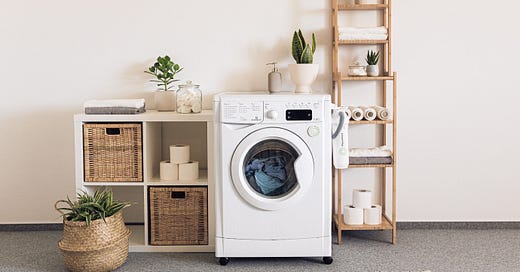How to do laundry in a sustainable way
Our most common activity since the first century but done in a responsible way.
One of the most important activities in every household is doing the laundry. It is a typical activity, even though in these times of consumerism and fast fashion it might seem that some people do not use washing machines and dryers. We all do it.
However, doing our laundry generates critical negative effects on nature that we may not consider, which tends to be generally due to ignorance.
Among the main effects generated by doing the laundry we have:
I. Chemical contamination of water
Generally, the most used products in our laundry are detergents, bleaches, and softeners. These products are a mixture of a group of compounds that are harmful to our waters, and unfortunately, in most cases end up affecting our rivers, seas, and oceans, as well as the life that inhabits them.
However, of all the products used in conventional washing, the king product that poses the greatest threat is detergent.
The main components of detergents are the following:
Phosphates
Colorants
Artificial fragrances
Dioxanes
Ammonium sulfates
Chlorine
Formaldehyde
All of these products have one characteristic in common, they can affect health to a great extent. They can cause allergic skin reactions, lung damage, eye damage, and damage to the nervous system, among other vital organs.
It can even disable water bodies through eutrophication.
II. Physical pollution
It is not unknown to anyone which product currently represents a major problem in the area of solid waste: plastic. Plastic is the most widely used material in the packaging and wrapping of a large part of the products used today. Detergents and fabric softeners are no exception.
Plastic ends up in our oceans in most cases because only 8% of the plastic we generate is properly treated and/or recycled. However, it is important to mention that in the laundry, the plastic generated is not only the one used as a container or packaging.
Microplastics are generated with the constant washing of garments made from synthetic fibers derived from petroleum such as polyester, polypropylene, and nylon. In addition, conventional detergents are often made from petroleum-derived raw materials.
What alternative do we have?
A few weeks ago, while I was working on writing a post for a client, I discovered a wonderful product, the eco-friendly laundry detergent in sheets. This ecological detergent is an alternative to conventional detergents that do not generate any type of waste, composed mainly of organic components of vegetable origin.
These are semi-solid sheets made of concentrated detergent. Another advantage they have compared to the detergents we normally use is that their packaging is generally made of paper or cardboard, but this does not mean that they are totally environmentally friendly.
Therefore, when choosing which type of sheet detergent to use, special attention must be paid to the components it contains.
What are these eco-friendly detergent sheets made of?
These sheets are made with a mixture of vegetable products and water. This makes it a totally eco-friendly product.
Specifically, it contains the following products:
Water: The quantities vary with respect to the manufacturer.
Dodecanol: Gives the detergent the ability to clean clothes.
Polyglycerol Ether: This is a solvent that separates stains from clothes.
Resins: This is what helps to give the shape and consistency of the sheet. As well as water, the amount of resin and the type of resin used will depend on the manufacturer.
However, to facilitate the purchase of ecosheets, it is only necessary that it does not contain the chemical compounds used in conventional detergents, which we mentioned above.
What makes them a better choice?
The main advantages that these sheets have over conventional detergents are the following:
They are free of petroleum-derived compounds and/or microplastics.
They are free of any chemicals or additives that are harmful to all kinds of life and the environment.
As is a common feature of eco-friendly alternatives, they are free of unnecessary and time-consuming packaging. They are usually packaged in cardboard or paper.
Extra tips for eco-friendly laundry
Other actions you can include are the following:
Buy more eco-friendly clothes: A characteristic of clothes in these times of fast fashion is that they are made up of fibers derived from plastic. Fibers to avoid are polyester, a material derived from PET. Make sure that the clothes you buy are made of more eco-friendly materials. Some options could be cotton, soy, bamboo, Kombucha, hemp, and linen.
Reduce all plastics used in the laundry: Beyond the products used for washing, a recommendation would be to stop buying clothes hangers or baskets made of plastic and replace them with more durable alternatives with less degradation time such as bamboo, aluminum, or other biodegradable alternatives.
Check the washing machine filter: Washing machines have a filter, at least most of them. It is important to check if yours has one or if the one it has is in good condition. Remember that when washing our clothes microplastics are generated and these filters can help prevent most of this from passing through our washing machines.
Use other organic alternatives: Just as there are eco-friendly detergents in sheets, there are other alternatives to chemical products of vegetable origin and of easier access. For example, vinegar or baking soda can work as a bleaching product, replacing industrial bleaches.
A little bit of spam
If you know someone who is interested in my services as a copywriter or content writer about sustainability, environment, and eco-lifestyle, you can tell them about me: Environmental and sustainability content writer.
Until next time,
.
.
.
Jr Nicolas de ReduceEntropy🌎







